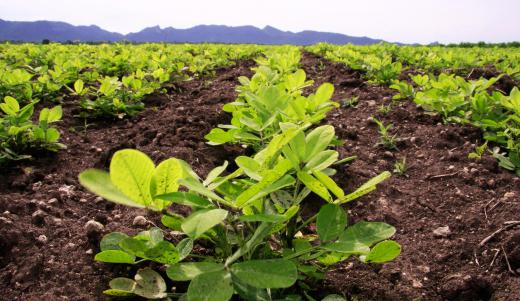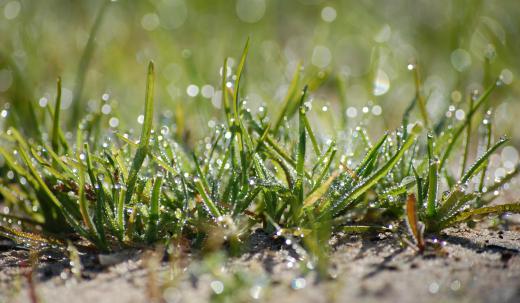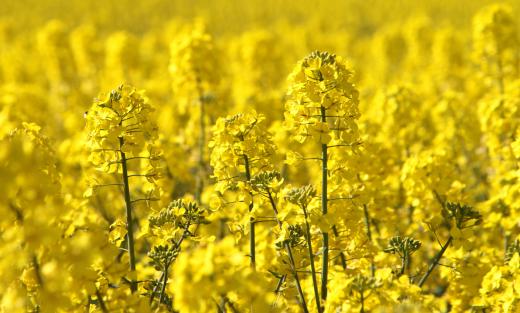What is White Mold?
 Niki Foster
Niki Foster
White mold, or sclerotinia, is a plant disease caused by fungal infection. The fungus Sclerotinia sclerotiorum is the most common culprit, but some other Sclerotinia species also infect plants. This disease is also sometimes called stem rot, stalk rot, wilt, or head rot. The fungus is most common in temperate climates, though it can grow in a wide variety of ecological environments. Sclerotinia sclerotiorum is one of the most successful plant pathogens, and it affects some of our most important food crops.
Roughly 408 different broadleaf plant species, including soybeans, sunflowers, peanuts, lentils, chickpeas, and canola, can be infected with white mold. Many weeds, including thistle and wild mustard, are vectors for the disease. Sclerotinia can be introduced into a healthy crop in many ways. In addition to being spread by infected weeds and other plants, it can be spread into adjacent crops through soil, wind, and irrigation water or rainwater.

Sclerotinia sclerotiorum has an overwintering structure called the sclerotium, which consists of a protective black rind covering a light-colored medulla. The sclerotium remains in the soil during the winter and germinates in the spring through one of two methods. It may form small mushrooms that release spores into the air to infect plants, or it may form a mycelium, the vegetative portion of a fungus, that directly affects the roots of nearby plants.

This fungus is a necrotrophic organism, meaning that it feeds on dead or decaying tissue. When it infects plants, it kills plant tissue before the mycelium begins growing on the plant. A common symptom of an infection is water-soaked spots on the plant, which eventually become covered with a white, cottony layer and become soft and slimy.
Some infected plants, on the other hand, develop dry lesions around the base that cause the plant to die. The plant's leaves also dry out, becoming yellow, then brown, before they die. Plants with white mold typically wilt and collapse or drop their leaves, spreading more of the fungus into the soil and causing nearby plants to become infected.

White mold is very difficult to control. It is not known how long Sclerotinia sclerotiorum can remain active in a field, but moisture and heat in the soil both contribute to its growth. Some methods for controlling the spread of the mold include the introduction of fungal parasites into the soil, the use of fungicides, crop rotation, and sanitation practices.
AS FEATURED ON:
AS FEATURED ON:
















Discussion Comments
I've noticed white mold growing on moss. It's always in a moist, dark area, like under the trees out in the pasture beside my house.
I know that moss likes a lot of moisture, so I'm not surprised that mold would grow along with it. The sun doesn't hit those spots, so there's nothing to dry it out.
@orangey03 – Probably not. I got white mold in the soil around my potted plants, and all I had to do was let the soil dry out.
You are probably just watering your plant too much. You should wait until the dirt is dry, even if it is time for your biweekly watering. Don't go by a schedule, but go by how the dirt feels.
If this doesn't work and your plant starts to look sickly, just repot it with new soil. Get rid of the soil with the mold on it, and don't use it for planting anything else.
Has anyone here ever seen white mold growing on potting soil? I have a plant in my office that I water a couple of times a week, and just last week, I noticed some white spots in the soil. Do I need to apply something to kill it?
@FirstViolin – I don't have any white mold removal tips, but I can tell you how to prevent it. I've always heard that it's best to water plants in the morning, because they have plenty of time during the day to dry out.
If you water them at night, the cool, moist air combined with the wet leaves can cause mold to grow. They don't have the help of the sun and the heat of the day to dry out.
what is the white mold on the sheeting of the underside of the roof as i am in attic looking up?
Patricia
air movement in your home can help. Movement of air in the home is very important to have a healthy home. Also will reduce moisture.
I get the worst white mold in my basement. There's no plants down there, so I don't have that problem, but what could cause this?
And how do I stop it?
Help!
@FirstViolin -- You may want to try a fungicidal spray on them. There are several varieties; most garden stores will be able to help you out.
Also, when you water them, make sure that you don't leave water sitting on the leaves afterwards -- that's a really quick way to get mold and mildew.
You may also want to make sure that the source of the while mold isn't the soil. Sometimes you can get white mold in your soil without even knowing it, and it can creep up into your plants.
If that's the case, you may have to move your plants entirely until you can kill the mold.
Best of luck!
Does anybody know how I get rid of white mold and fungus on my roses?
They just keep getting this gross white, furry mold on them, and I can't seem to kill it.
Does anybody have any tips or help?
Post your comments